How Big Is the Sun Compared to Earth
The Sun - how far? how big?
"Space is big. Really big. You just won't believe how vastly hugely mind-bogglingly big it is. I mean, you may think it's a long way down the road to the chemist, but that's just peanuts to space."
- from The Hitchhiker's Guide to the Galaxy, by Douglas Adams
Even the distances in the neighborhood of our "small unregarded yellow sun", which lies "far out in the backwaters of the unfashionable end of the Western Spiral arm of the Galaxy" (as Adams phrased it in the opening sentence of The Hitchhiker's Guide to the Galaxy), are indeed mind-bogglingly vast. We begin our exploration of the Sun, which is the main source of energy for Earth's climate system, with a feeble attempt to comprehend the size scale of the Sun as compared to Earth. First, we'll look at the distance to the Sun; then we'll discuss the size of our neighborhood star as compared to our home planet. Be prepared to feel small!
Distance to the Sun
The Sun is about 149 million km (93 million miles) from Earth. This is the average distance; since Earth's orbit is an ellipse, not a perfect circle, the Earth-Sun distance varies slightly throughout the year. In early January when the Earth is at perihelion (Earth's closest point to the Sun in each orbit), Earth comes within 147.09 million km (91.40 million miles) of the Sun. In July, when Earth reaches aphelion (its furthest point from the Sun), it recedes to a distance of 152.10 million km (94.51 million miles) from the Sun. Thus the Earth-Sun distance varies by about 3%, or roughly 5 million km (3 million miles), over the course of a year. Remember, this variation in distance is NOT the cause of our seasons on Earth. This is a misconception held by many students, so beware of this when discussing this topic with your students.
During the Apollo space program that sent astronauts to the Moon, the trip from Earth to the Moon took slightly more than two days. That Sun is 389 times as far from Earth as is our Moon. At the average speed of the Apollo flights, a trip to the Sun would take more than two years.
Modern commercial jetliners cruise at speeds near 600 miles per hour (966 km/hr). At that speed, a journey to the Sun from Earth would last more than 17 years.
Light travels at the ridiculously fast speed of 300,000 km/sec (186,000 miles/sec). It could circle the Earth seven times in a single second. Nevertheless, light takes 8 minutes 19 seconds to make the trip from the Sun to Earth. This is a significant time lag, and means that we don't see changes that occur on the Sun until several minutes after they actually happen.
Size of the Sun as compared to Earth
The Sun has a diameter of about 1,392,000 km (~865,000 miles). Earth's diameter is 12,742 km (7,917.5 miles). The diameter of the Sun is thus 109 times as great as the Earth's diameter. In other words, you could line up 109 Earths across the face of the Sun.
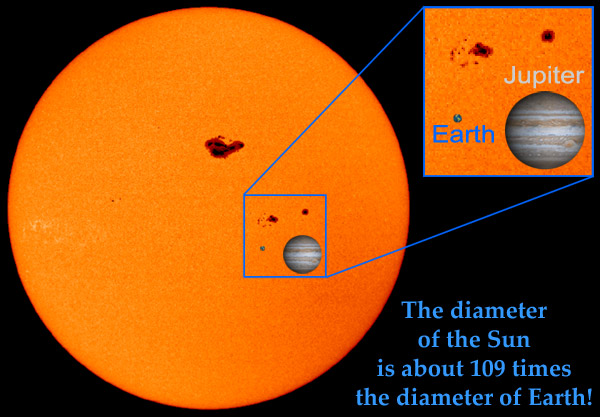
The Sun is about 109 times as large as Earth, in terms of diameter. This picture shows the Sun (with some sunspots), Jupiter, and Earth to scale. (Click image to enlarge)
Credit: Original artwork by Randy Russell. Sun image courtesy SOHO/ESA/NASA. Jupiter image courtesy NASA/JPL/University of Arizona.
The volume of a sphere varies as the cube of the sphere's diameter. Since the Sun's diameter is more than 100 times as large as the Earth's, the volume of the Sun is more than a million times the Earth's volume. To be more precise, the Sun's volume is roughly 1,304,000 times as great as Earth's. You could fit a whole lot of Earths inside of the Sun!
Even Jupiter, the largest planet in our solar system, is much, much smaller than the Sun. Although Jupiter's diameter is roughly 11 times as large as Earth's, the Sun's diameter is still almost 10 times as great as Jupiter's. In terms of volume, the Sun is 987 times as large as Jupiter, which is 1,321 times as large as Earth.
Since the Sun is mostly made of hydrogen, which is much less dense than the rock that makes up most of Earth, the Sun "outweighs" our home planet to a lesser degree than it "out-volumes" Earth. The Sun's mass (1,989,100 x 1024 kg) is "only" 333,000 times as great as Earth's (5.97 x 1024 kg). In terms of mass, the Sun is by far the dominant feature of our solar system; the Sun contains more than 99% of the mass of the entire solar system!
Table of Facts about the Sun and Earth
| | Sun | Earth | Sun/Earth ratio |
| Diameter (average) | 1,392,000 km | 12,742 km | 109 |
| Volume | 1,412,000 x 1012 km3 | 1.08321 x 1012 km3 | 1,304,000 |
| Mass | 1,989,100 x 1024 kg | 5.9736 x 1024 kg | 332,980 |
| Sun to Earth distance (average): | | 149.60 million km (92.96 million miles) |
| | | 8.3 light minutes |
| | | 389 times the Earth-Moon distance |
Surely you don't expect me to remember all of this!
How can one keep track of this plethora of facts about the Sun, or at least the most important ones? Here's our take on estimates of the most critical factual notions about the Sun, and a few mathematical concepts to help relate them:
- Recall that the Sun is roughly 100 times as large, in terms of diameter, as Earth. This fact, plus some basic geometry (volume trends as the cube of linear distance), leads to the volume of the Sun being approximately a million times (1003 = 100 x 100 x 100 = 1,000,000) Earth's volume.
- Recall that light travels almost a million kilometers in three seconds (that is, the speed of light is roughly 300 thousand km/sec), and that light that departs from the Sun reaches our planet about eight minutes later. These two facts plus a little math can lead you to a reasonable approximation of the distance from the Sun to the Earth, as follows:
- 8 minutes x 60 seconds/minute = 480 seconds
- 480 seconds � 3 seconds per million km = 160 million km
- this value is within about 7% of the actual value of 149.6 million km, and is thus a fair estimate
- The mass of anything else in the solar system is miniscule compared to our star, for the Sun accounts for more than 99% of the mass of the entire solar system.
You might also be interested in:
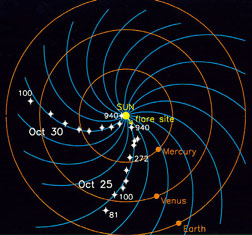
IMF
IMF stands for Interplanetary Magnetic Field. It is another name for the Sun's magnetic field. The Sun's magnetic field is enormous and is carried by the solar wind. The solar wind and magnetic field are...more
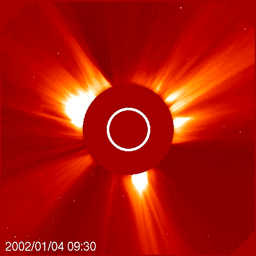
Coronal Mass Ejections
"Without warning, the relatively calm solar atmosphere can be torn asunder by sudden outbursts of a scale unknown on Earth. Catastrophic events of incredible energy...stretch up to halfway across the visible...more
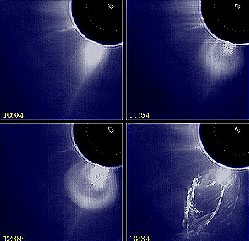
Solar Activity
The Sun is not a quiet place, but one that exhibits sudden releases of energy. One of the most frequently observed events are solar flares: sudden, localized, transient increases in brightness that occur...more
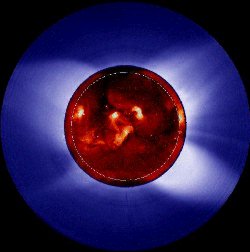
The Solar Atmosphere
The visible solar atmosphere consists of three regions: the photosphere, the chromosphere, and the solar corona. Most of the visible (white) light comes from the photosphere, this is the part of the Sun...more
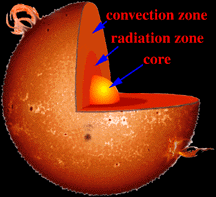
The Solar Interior
To understand how our Sun works, it helps to imagine that the interior of the Sun is made up of different layers, one inside the other. The innermost layer, the solar core, is the region where the energy...more
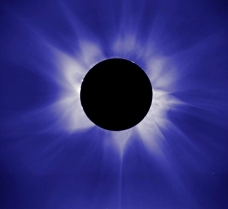
High Altitude Observatory
Scientists at the High Altitude Observatory (HAO) are working to understand the changes we see in the Sun over time, and how these changes affect the atmosphere of the Earth. There are four main areas...more
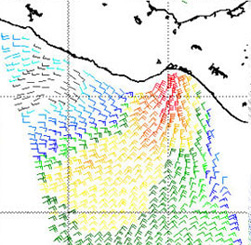
Sun's Effect on Earth's Weather (Wind)
Energy from the Sun is one of the primary drivers of the Earth system. The Sun warms our planet, heating the atmosphere. This energy feeds atmospheric processes and is a primary driver of our weather....more
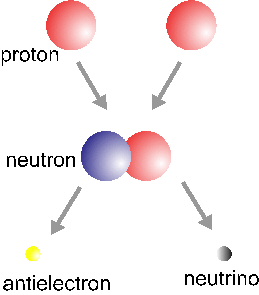
The Hydrogen Fusion Process
The basic Hydrogen fusion cycle involves four Hydrogen nuclei (protons) and two electrons and yields a Helium nucleus, two neutrinos and six photons. This process occurs in three steps: the first one is...more
How Big Is the Sun Compared to Earth
Source: https://www.windows2universe.org/sun/sun_size_distance.html